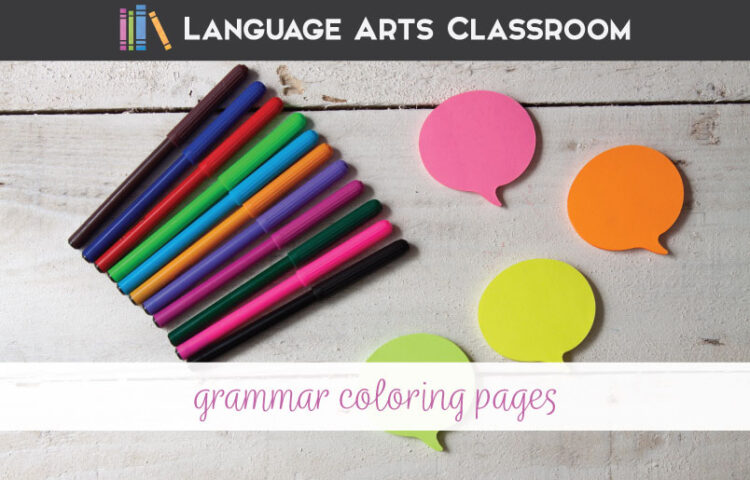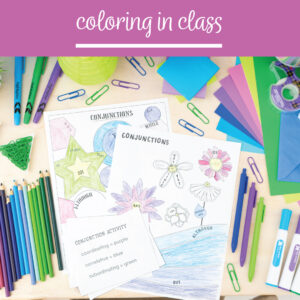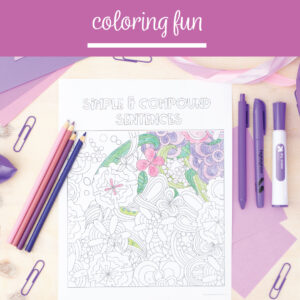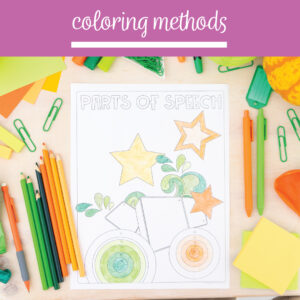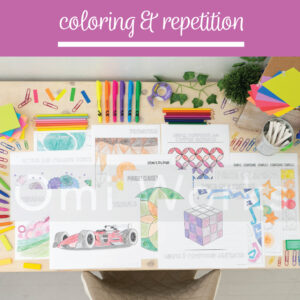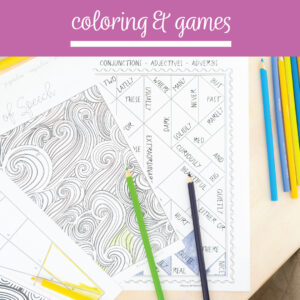How can grammar coloring pages improve your grammar lessons? Is it possible. . . to have fun grammar?
Previously, I’ve written about coloring sheets for literature or note taking as well as art in language arts. My experimentations continue with infographics and with hands-on grammar. As I work with students and create new activities, I keep in mind to keep my mind open.
One of my goals as a teacher is to present material in different ways. My personal preferences—lists and flash cards— will not work for everyone.
Which? Is great! However students learn about language arts, I am wiling to work with them. That willingness leads to success with fun grammar activities.
The more teachers talk about grammar coloring pages, the more fun and engagement we share. Keep reading for teaching methods, grammar games, and domain-specific vocabulary—all with grammar coloring activities.
Why should students color in class?
In short: Coloring is fun, and when students have fun, they remember the material.
In a longer analysis, I am incorporating more grammar coloring sheets because my classes crave new ways of learning. My classes seem different after COVID—they’ve changed, and I don’t think all of the change is negative. I was a graduate student during the pandemic, and I learned about my learning styles and preferences sitting at home in class. (And I am old with lots of learning experiences!) Our students did too.
I see learners who experienced learning in new ways. Circumstances forced them to experiment; they presented virtually, read independently (with choice books), and found new study methods.
Of course—not perfectly and not everywhere. With these examples, I am speaking anecdotally. Some of my students found success during lockdown. All students discovered what did not work for them.
But? Across all my classes, all students are asking for different learning methods. Coloring in class makes sense many times.
Grammar and coloring fun. . .
I do not color to relax, but I know some adults who do color. Instead, I write and doodle, crotchet, and read. When I need a break, I know what will help me. My students might not know their best relaxation techniques or brain breaks.
Just as I present digital games and graphic organizers to study, I present grammar coloring as another learning method. We often close specific grammar lesson plans with coloring. Additionally, if a class needs to review a previous topic (like parts of a sentence) before building on a large topic (like sentence structure), a brief review combined with coloring helps.
When I provide grammar coloring pages, I’m hoping to take an often stressful practice (grammar) and combine it with a relaxing activity (coloring). These learning tools can provide excitement about new concepts.
What are methods for grammar coloring activities?
With grammar coloring pages, the following process helps students to find success:
- Review the content, the terms, the concept’s use before students begin coloring. For instance, with a parts of speech coloring sheet, I would pull an anchor chart or review concept that defines each part of speech. We might practice confusing words (like “for”) that can be used in different ways. We review before I even hand out the coloring pages.
- Ask students to identify the concept in use. Students should work on the sentences before coloring. When students move back and forth (from sentences to coloring), they often switch answers—even if they have the correct answer. The switching from sentences to coloring sheet confuses them. I hand out the sentences before I distribute the grammar coloring pages.
- Then! Give students the coloring pages. Ask them to consult the concepts in the practice sentences to be sure they are coloring correctly.
- Put the finished grammar coloring activity on display, and let students check their answers.
- All of my grammar products have a polished answer key. Display a “correctly” colored sheet.
Consider: After step two, you might ask everyone to check their answers with you or a peer. This discussion is a brain-based learning approved strategy, and you’ll save coloring errors.
Coloring and repetition. . .
Repetition and domain-specific vocabulary: hmmmm. Repetition in a variety of ways helps students. For this post, I set out to find research.
In my experience, students use terms like setting, theme, argument, and claim—often easily! Most older students use some ELA domain-specific language.
(I’ve written before about the trouble this set of language arts teachers face concerning grammar: Many teachers received little or no or poor grammar instruction, but today’s standards dictate that teachers cover complex language concepts. If you are concerned about “talking about grammar,” you are not alone.)
If learning domain-specific language requires repetition, what does the research say about repetition?
In the paper, “Repetition is the First Principle of All Learning” by Robert F. Bruner, he emphasizes not only the importance of repetition, but also provides five opportunities to repeat ideas. He states:
Create many small opportunities to reinforce, revisit, and repeat ideas.
Bruner’s entire paper is only three pages, and all of it provides worthwhile ideas concerning time frames, delivery methods, and opportunities.
In grammar, coloring allows for a small opportunity to reinforce, revisit, and repeat ideas. For instance, if we take that parts of speech coloring sheet from above, we might use the process as part of the repetition. Incorporate the recall of definitions, the identification of terms in sentences, and the answer-check of coloring with the terms.
Can grammar coloring activities be a game?
Yes! Grammar coloring sheets provide opportunities for grammar games. If you want to turn the grammar coloring pages into a game, have students race, complete the most correct questions, or “switch and pass” around the room.
Most often, I use coloring sheets as a station with grammar stations. A designated spot (complete with colored pencils) is part of the station rotations. Students can color two or three parts, and then the next group will color another two or three spots. The finished coloring sheet is a classroom decoration.
Overall, grammar fun can work. . .
If you think “grammar fun” is an oxymoronic expression, I once thought that too. Hands-on pieces like grammar task cards and manipulative led me to working with splashes of color!
Consider:
When we open a story, we ask students to “think about a time that they. . .” We read informational texts that present engaging and high-interest topics that relate to their lives. Finally, we give readers choice in their independent reading material.
We ELA teachers meet students where they are in their understanding for other parts of class. With grammar coloring activities, we just have another tool for reaching students.
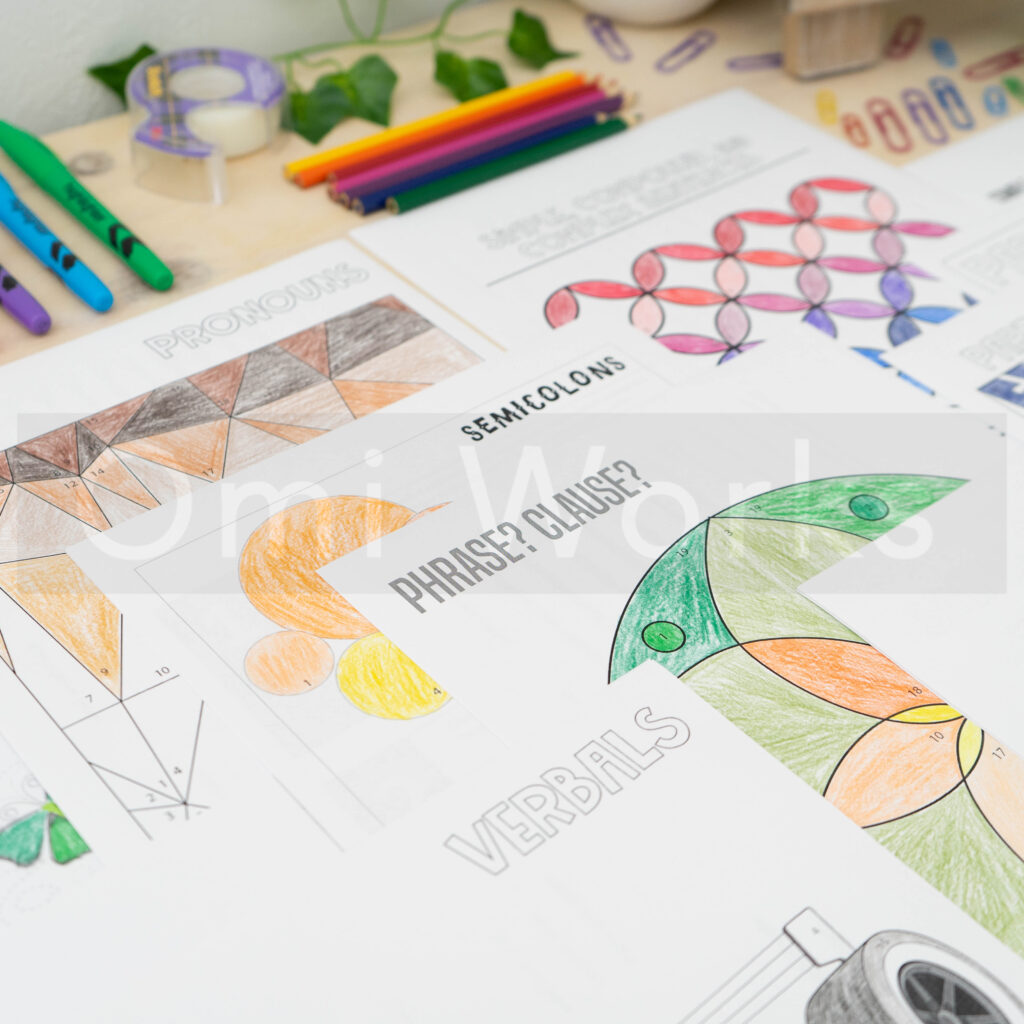
Are you looking for a middle school grammar bundle? Click the above picture!

